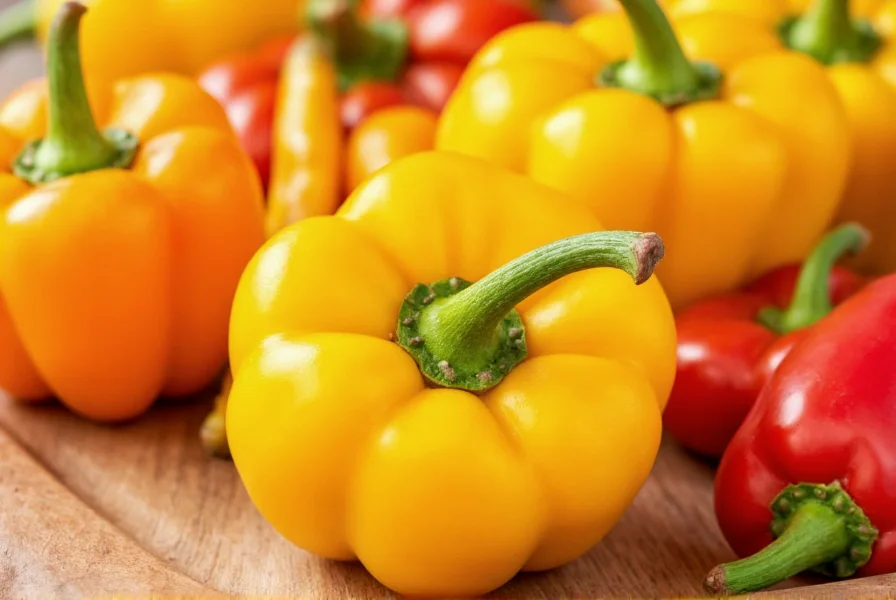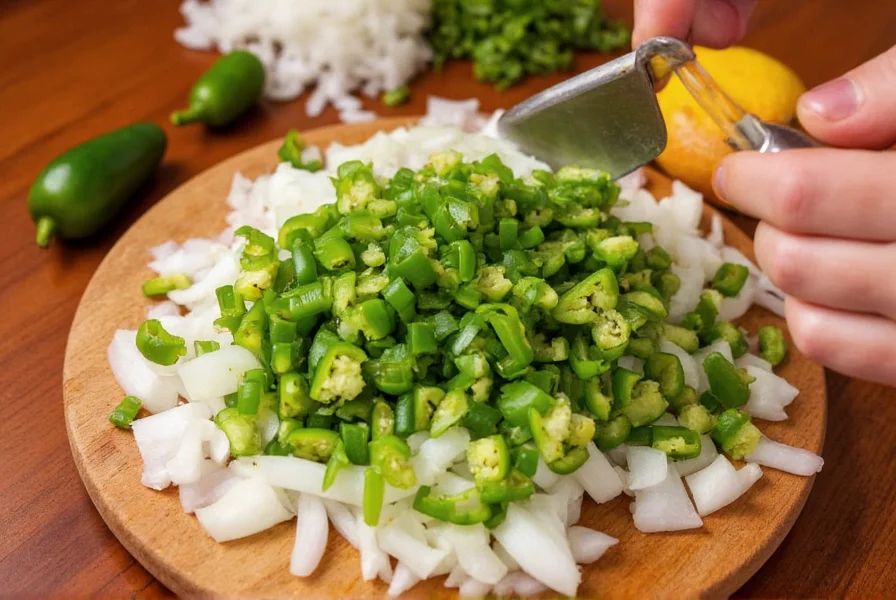Ajicito peppers, often called ajíes dulces or sweet habaneros, represent a culinary cornerstone across Caribbean kitchens. These vibrant peppers deliver complex flavor without significant heat, distinguishing them from their spicier relatives. Understanding their unique characteristics helps home cooks and professional chefs alike harness their full potential in traditional and contemporary dishes.
Origin and Botanical Background
Contrary to what their name suggests, ajicito peppers belong to the Capsicum chinense species, sharing lineage with habaneros and Scotch bonnets. Native to the Caribbean islands, particularly Puerto Rico and the Dominican Republic, these peppers have become integral to regional cooking traditions. The name 'ajicito' (Spanish for 'little chili') creates a common misconception about their heat level, when in reality they're among the mildest members of the chinense family.

Physical Characteristics and Varieties
Ajicito peppers typically measure 1-2 inches in length with a distinctive tapered shape. They mature through color stages:
| Color Stage | Flavor Profile | Common Usage |
|---|---|---|
| Green | Grassy, slightly bitter | Sofrito base, stews |
| Yellow | Sweet, citrusy notes | Raw in salsas, finishing dishes |
| Orange/Red | Fruit-forward, tropical notes | Drying, sauces, specialty dishes |
Unlike many chili varieties, ajicitos maintain consistent mildness regardless of color stage. Their thin walls make them ideal for raw applications where texture matters.
Flavor Profile and Heat Analysis
The ajicito pepper's most remarkable feature is its near-absence of capsaicin, the compound responsible for chili heat. With a Scoville rating of 0-500 units, they're significantly milder than even bell peppers (which register 0 units but lack the ajicito's complex flavor). This places them in the same heat category as pimento peppers.
What ajicitos lack in heat they compensate for with nuanced flavor notes:
- Citrus undertones (particularly lemon and orange)
- Tropical fruit hints (mango, papaya)
- Subtle earthiness reminiscent of fresh herbs
- Delicate sweetness that intensifies when cooked
Culinary Applications Across Caribbean Cuisine
Ajicito peppers serve as the aromatic foundation in Puerto Rican sofrito, the flavor base essential to dishes like arroz con gandules and mofongo. Chefs finely dice them with onions, garlic, and culantro to create this culinary cornerstone.
Professional chefs value ajicitos for several specific applications:
- Raw preparations: Their thin walls and mild flavor make them perfect for fresh salsas and relishes without overwhelming other ingredients
- Cooked dishes: They mellow beautifully in stews and braises, contributing depth without heat
- Infused oils: Their delicate flavor transfers well to oils without the bitterness sometimes found in stronger chilies
- Garnishes: The vibrant colors provide visual appeal to finished dishes

Where to Find Ajicito Peppers
Finding authentic ajicito peppers outside Caribbean communities can prove challenging. Your best options include:
- Specialty Latin American grocery stores (particularly those focusing on Puerto Rican products)
- Caribbean farmers' markets during peak growing season (summer through fall)
- Online seed retailers for home cultivation
- Some high-end grocery chains with robust international produce sections
When shopping for ajicito peppers, look for firm specimens with smooth, unblemished skin. They should feel heavy for their size, indicating freshness. Avoid peppers with soft spots or wrinkled skin, which suggest age.
Effective Ajicito Pepper Substitutes
When authentic ajicitos prove unavailable, several alternatives can approximate their flavor profile while maintaining the required mildness:
- Shishito peppers: Offer similar thin walls and mild heat with complementary citrus notes
- Italian frying peppers: Provide the right texture and mild flavor, though slightly less complex
- Mini sweet peppers: Readily available alternative that captures the sweetness without heat
- Combination approach: Mix bell peppers with a tiny amount of banana pepper for complexity
When substituting in traditional recipes like sofrito, maintain the same volume measurement while adjusting for slight flavor differences. The key is preserving the mildness that defines authentic Caribbean preparations.
Growing Ajicito Peppers at Home
Home gardeners can successfully cultivate ajicito peppers with proper care. These tropical plants require:
- Full sun exposure (6-8 hours daily)
- Well-draining soil with consistent moisture
- Warm temperatures (70-85°F ideal)
- Regular feeding with balanced fertilizer
Start seeds indoors 8-10 weeks before last frost date. Transplant outdoors when nighttime temperatures remain above 60°F. Plants typically reach 2-3 feet in height and produce abundant fruit within 70-80 days of transplanting. The harvest window extends throughout the growing season as peppers mature through their color stages.
Nutritional Benefits of Ajicito Peppers
Beyond their culinary value, ajicito peppers offer notable nutritional advantages:
- Exceptionally high in vitamin C (more than citrus fruits by weight)
- Rich in vitamin A precursors (beta-carotene)
- Contain capsaicinoids with potential metabolic benefits
- Low calorie density (approximately 20 calories per 100g)
- Provide dietary fiber that supports digestive health
Unlike hotter chili varieties, ajicitos deliver these benefits without the gastrointestinal irritation that can accompany significant capsaicin consumption, making them accessible to a wider range of diners.
Preservation Techniques for Year-Round Use
To enjoy ajicito peppers beyond their seasonal availability, consider these preservation methods:
- Freezing: Blanch whole peppers for 2 minutes, cool in ice water, then freeze in airtight containers (best for cooked applications)
- Drying: Use a food dehydrator at 135°F for 8-12 hours; reconstitute in warm water for cooking
- Oil preservation: Submerge in olive oil with garlic and herbs for flavored cooking oil
- Refrigeration: Store unwashed in perforated plastic bags for up to 2 weeks
For traditional sofrito preparation, many Caribbean cooks freeze pre-chopped ajicitos in ice cube trays with other aromatics for convenient portioning.
Common Misconceptions About Ajicito Peppers
Several misunderstandings persist about these versatile peppers:
- Misconception: Ajicitos are spicy peppers
Reality: They're among the mildest chili varieties, with heat levels comparable to sweet bell peppers - Misconception: They're the same as ají chombo
Reality: Ají chombo refers to habanero-type peppers, which are significantly hotter - Misconception: All small peppers are interchangeable
Reality: Flavor profiles vary dramatically even among mild varieties
Conclusion: Embracing the Essence of Caribbean Flavor
Ajicito peppers represent far more than just another chili variety—they embody the culinary spirit of Caribbean cooking. Their unique combination of mildness and complex flavor makes them irreplaceable in traditional preparations while offering versatile applications in contemporary cuisine. Whether you're preparing authentic Puerto Rican sofrito or experimenting with new flavor combinations, understanding ajicito peppers' distinctive characteristics unlocks new dimensions in your cooking. As interest in global cuisines continues growing, these humble peppers deserve recognition for their significant contribution to Caribbean culinary heritage.
Frequently Asked Questions
Are ajicito peppers the same as ají dulce?
Yes, ajicito peppers and ají dulce refer to the same pepper variety. The terms are used interchangeably in Caribbean cooking, with 'ajicito' being the diminutive Spanish form meaning 'little chili' and 'ají dulce' translating to 'sweet chili.' Both names describe the same mild, flavorful pepper essential to Puerto Rican and Dominican cuisine.
Can I use regular bell peppers as a substitute for ajicito peppers?
While bell peppers can substitute for ajicito peppers in recipes requiring mildness, they lack the distinctive citrus and tropical fruit notes that define ajicitos. For a closer approximation, combine bell peppers with a small amount of banana pepper or shishito pepper to capture some of the complexity. In traditional sofrito preparations, this substitution works acceptably though the flavor profile will be less nuanced.
Why are ajicito peppers essential in Puerto Rican sofrito?
Ajicito peppers provide the foundational aromatic complexity in authentic Puerto Rican sofrito without introducing heat. Their mild sweetness balances the pungency of onions and garlic while their citrus notes complement culantro, creating the distinctive flavor base essential to traditional dishes. Unlike hotter peppers, ajicitos mellow beautifully during cooking, integrating seamlessly with other ingredients rather than dominating the flavor profile.
Do ajicito peppers change heat level as they ripen?
No, ajicito peppers maintain their extremely mild heat level (0-500 Scoville units) throughout all ripening stages. Unlike many chili varieties that increase in heat as they mature, ajicitos remain consistently mild whether green, yellow, orange, or red. The primary changes during ripening affect flavor complexity and sweetness, with riper peppers developing more pronounced tropical fruit notes while retaining their characteristic mildness.











 浙公网安备
33010002000092号
浙公网安备
33010002000092号 浙B2-20120091-4
浙B2-20120091-4